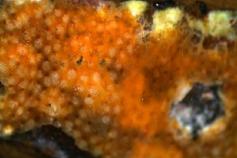You are here
Suroeste de Fuerteventura - June Campaign - IEO
The identification and mapping of biogenic habitats and the characterization of benthonic and demersal communities were the objectives established for the INFUECO 0611 expedition to be carried out on board the Miguel Oliver oceanographic vessel.
The specific objectives were:
- To attain and subsequently process geophysical data.
- To perform type analysis of sedimentary and rock matter.
- To perform depth profiles of temperature, salinity, dissolved oxygen and fluorescence variables.
- To establish an epi and endobenthic fauna inventory for the habitats under study.
- To ascertain the characterization and spatial distribution of the various habitats and their associated epi and endobenthic communities.
- To obtain estimates regarding abundance and biomass of the various species comprising the area’s epi and endo benthos.
The workstations in the INFUECO 0611 campaign were multipurpose so that each station, not only on this expedition but on previous and subsequent expeditions as well, performed direct sampling of several types of benthos, including both epi and endobenthonic. There were two types of stations according to seabed types, either sedimentary or soft, or rocky or hard. A total of 17 rock dredges (10 in Amanay and its slope and 7 en El Banquete and its slope) ranging from 30 to 1.500 m deep, 18 box-corers between 70 and 1.200 m deep, and 18 beam trawls (11 in Amanay and its slope and 7 en El Banquete and its slope), between 70 and 1.200 m deep were performed during the expedition.
Due to technical problems, the sampling during the INFUECO 0710 expedition was limited to a maximum depth of 400 m. The sampling on the tops of the banks was expanded for this INFUECO 0611 expedition as compared to the previous expedition. The same methodology was used, but up to a depth of 1500 meters.
In order to collect data on the macrozooplankton in the first few meters of water from the bottom, which is significant both from a trophic point of view of and due to the pelagic to benthic transition and vice versa (benthic pelagic coupling), a total of 35 WP2 plankton net trawls (21 in Amanay and its slope, 14 in El Banquete and its slope) were performed between 30 and 1.580 m in depth.
Thirty six CTD stations were established on six radials parallel to the equator from the north of Amanay to the south of El Banquete so that the effort made in terms of the number of days could cover the potential inward and outward flow of the current as well as the area’s bathymetric variability.
RESULTS
The information gathered during the INFUECO 0611 campaign is being analyzed to produce results. Although results on geomorphology, infauna, and macrozooplankton are not yet available, preliminary results of the macrofauna’s benthic portion and preliminary hydrographical results are available.
The total number of benthic individuals gathered with the two samplers used in the expedition was 29.832. Their biomass was 73.703 g and included approximately 450 species belonging to 13 different phyla.
Comparing the overall results with those in the same areas from last year’s expedition, and taking an average per haul since the number of hauls was lower, the average abundance of biomass is slightly greater on this expedition. In addition, the number of morphospecies collected is much greater, 450, given that in 2010, 180 different taxons were accounted for. This may be due to two factors: more identification on board and the greater range of depth sampled.
Hydrographic profiles were obtained on all 36 stations, enabling results to be observed in their ensemble and similarities and differences between the groups or subgroups to be established. The behavior of the profiles was observed to be similar for temperature, dissolved oxygen and florescence variables, although this was not the case for salinity variables.
T/S diagrams, potential temperature over salinity, were done for each transect, enabling the different water masses in the area under study to be identified. These areas include: la NACW (North Atlantic Central Water), the AAIW (Antarctic Atlantic Intermediate Water) generated in the Southern Ocean, the MW (Mediterranean Water), and the NADW (North Atlantic Deep Water) with its origins in the Labrador Sea and in the Nordic Seas.
Acknowledgments
The authors of this report and all of the participants in the expedition would like to thank the Miguel Oliver oceanographic vessel’s crew for its great professionalism and dedication which were particularly appreciated in this expedition far off the coast and involving a combination of several samplers.
Thanks as well to the SGM for lending equipment and enabling its use during the campaign on board the Miguel Oliver, and to Eugenio Fraile, from the Centro Oceanográfico de Canarias under the Instituto Español de Oceanografía (Spanish Institute of Oceanography), for his advice on the design of the CTD sampling, and to Vanesa Papiol from the Instituto de Ciencias Marinas de Barcelona for her effectiveness and for swiftly sending what was needed for the macrozooplankton sampling

















